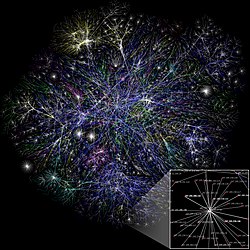
Back Semantiese netwerk Afrikaans شبكة دلالية Arabic আর্থিক জালতন্ত্র Bengali/Bangla Xarxa semàntica Catalan Semantisches Netz German Red semántica Spanish شبکه معنایی Persian Semanttinen verkko Finnish Réseau sémantique French Rete semantica Italian

| Part of a series on | ||||
| Network science | ||||
|---|---|---|---|---|
| Network types | ||||
| Graphs | ||||
|
||||
| Models | ||||
|
||||
| ||||
 |
| Information mapping |
|---|
| Topics and fields |
| Node–link approaches |
|
| See also |
A semantic network, or frame network is a knowledge base that represents semantic relations between concepts in a network. This is often used as a form of knowledge representation. It is a directed or undirected graph consisting of vertices, which represent concepts, and edges, which represent semantic relations between concepts,[1] mapping or connecting semantic fields. A semantic network may be instantiated as, for example, a graph database or a concept map. Typical standardized semantic networks are expressed as semantic triples.
Semantic networks are used in natural language processing applications such as semantic parsing[2] and word-sense disambiguation.[3] Semantic networks can also be used as a method to analyze large texts and identify the main themes and topics (e.g., of social media posts), to reveal biases (e.g., in news coverage), or even to map an entire research field.
- ^ Cite error: The named reference
Sowawas invoked but never defined (see the help page). - ^ Poon, Hoifung, and Pedro Domingos. "Unsupervised semantic parsing." Proceedings of the 2009 Conference on Empirical Methods in Natural Language Processing: Volume 1-Volume 1. Association for Computational Linguistics, 2009.
- ^ Sussna, Michael. "Word sense disambiguation for free-text indexing using a massive semantic network." Proceedings of the second international conference on Information and knowledge management. ACM, 1993.
© MMXXIII Rich X Search. We shall prevail. All rights reserved. Rich X Search
